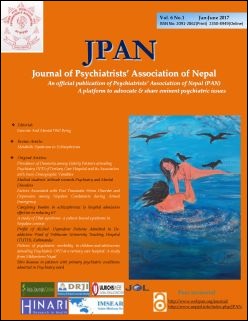A study of Dhat syndrome- a culture bound syndrome in Nepalese context
DOI:
https://doi.org/10.3126/jpan.v6i1.21770Keywords:
Culture Bound Syndrome, Dhat Syndrome, Semen LossAbstract
Introduction: Dhat syndrome is generally believed to be a culture-bound which is characterized by excessive preoccupation with loss of "Dhat", which is generally taken to be representing semen. The study evaluated the symptoms of patient with Dhat syndrome visiting three mental health clinics of Rupandehi district.
Material and Method This descriptive cross- sectional study was conducted in three different Psychiatry outpatient clinics at Rupandehi district of Nepal. Purposive sampling, a type of non-random sampling was utilized for the study. A total 50 patients with Dhat syndrome were enrolled in the study. A semi-structured Performa containing socio-demographic and Dhat syndrome symptoms related information was filled by respondents after providing written informed consent.
Results: The patients were predominantly young adults, male with mean age of 23.1±4.6. Majority of them were in age group 18-25 years, hindu by religion, living in non-urban areas, family income of 5000-10000 per month, literate and unmarried. A range of psychological and somatic symptoms associated with Dhat syndrome were revealed. Most common symptoms found in the study were excessive worries (96%), tingling sensation of body (86%), weakness (80%), decrease interest (80%), fatigue (76%), depressed mood (74%), and generalized body ache (72%).
Conclusion: Dhat syndrome presented with a range of psychological and somatic symptoms. Any male patient presenting with multiple somatic symptoms must be evaluated for Dhat syndrome and the physician must enquire about the semen loss and the associated beliefs.
J Psychiatrists’ Association of Nepal Vol .6(1), 2017, p.33-37
Downloads
Downloads
Published
How to Cite
Issue
Section
License
This license enables reusers to distribute, remix, adapt, and build upon the material in any medium or format, so long as attribution is given to the creator. The license allows for commercial use.




